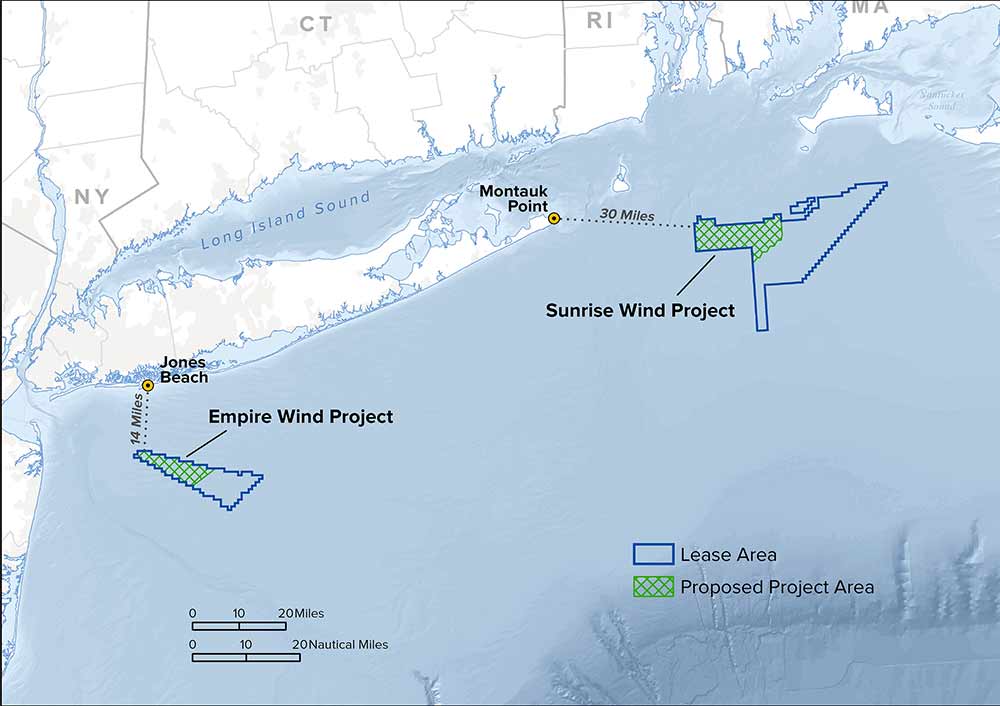Wires Down? Noyac Street Becomes Model for Taking Down Utility Poles

A group of homeowners who live across from Long Beach in Noyac have been given the go-ahead to take down the half-mile of utility poles that block their clear view of the bay there and have the power lines placed underground. There are 18 homes along that stretch, which is alongside Cliff Drive, and without power-lines the view of the bay will be stunning—a bit more stunning, anyway, than the view they have through the wires that are in the way now.
What’s interesting is that the discussion prior to the approval (vote 3–2) seems to contain everything you need to know about what putting wires underground costs.
The full cost of removing the nine telephone poles and their half-mile of wires is estimated to be $420,000. That annual cost will be borne entirely by the 18 homeowners, an average of about $1,200 per year each. And it will continue on every year for the number of years that a bond approved by the residents and backed by the Town continues, which is 20 years.
In other words, applying this same formula, if you wanted to beautify the one-mile length of the beautiful and historic Main Street in Bridgehampton—twice as long as Cliff Road—it could be done for about $840,000, which could be divided up to be paid back over 20 years by approximately 80 restaurants and stores that sit on that stretch, which would cost each property owner about $525 extra on their annual tax bill for 20 years.
Now, I have suggested this before. Bridgehampton has done a Cinderella, growing over the last half-century from a rough-and-tumble farming town with six gas stations, one print shop, numerous farm equipment shops, potato-packing plants, an electric shop, hardware store, meat market, plumbing shop and, at a certain point, two ice cream parlors—into a chic community with no gas stations, several four-star restaurants, designer clothing shops, high-end furniture shops, shoe stores, antique shops, exercise studios and art galleries.

At the same time, the public facilities, the museum, churches, parks, library, community center and the grand mansions have been all cleaned, polished, added on to, modernized to be sleek and fashionable or restored to what they looked like when they were built in the 17th, 18th and 19th centuries.
There was even a time not too long ago when there was no street furniture on Main Street. But in the 1970s, a group of private citizens formed the Bridgehampton Village Association and planted trees, benches, brick walkways and flower boxes and so here we are. Meanwhile, in spite of all this, we still have a tangle of telephone, internet and electric lines sizzling overhead atop thick wooden telephone poles that don’t even stand up straight, dancing between and around all the beautiful trees that now line the road from one end to the other.
The only things that remained all the same over all these years were the Candy Kitchen, Bobby Van’s and, at the east end of town, the thirty foot tall Founders Monument that sits in the middle of Main Street on a stone platform topped by an eagle with its wings spread.
Southampton Main Street long ago got its wires placed underground. East Hampton Main Street long ago got its wires placed underground. These two villages were founded in 1640 and 1648, respectively. Bridgehampton, founded in 1656, should have its ugly overhead wires placed underground immediately. I can’t imagine anybody objecting.
The ability to do this sort of thing, paid for by exactly the people who benefit from it, has already been put into place here. In has been made possible by the creation of an oceanfront barrier dune tax district that was approved by the oceanfront residents living along a six-mile stretch from Wainscott to Flying Point about 15 years ago. Originally, that group of homeowners—approximately 100 of them—wanted to create a pencil-thin incorporated village approximately 500 yards wide and all of six miles long.
It would be carved out from parts of East Hampton Town and Southampton Town, making access to the beach extremely difficult for everybody but them. Everyone fought this, and so, in the end, they group settled for a special tax district where they would pay for what benefitted them. This had never been done before, and so became the precedent for this special tax district plan just approved today.
All through the Hamptons, over the years, long scenic views of potato fields and dunes have been blocked by the creation of multimillion-dollar mansions whose owners have surrounded their properties with tall hedgerows. The view is now hedgerows, up close and personal. And the focus of life has now largely turned inward and inland. After Bridgehampton, the Village of Sag Harbor should look into burying all their power-lines, then perhaps Amagansett, and Westhampton Beach. There’s pride and beauty in our downtowns. We should show them off. It couldn’t be done before. Now it can.



